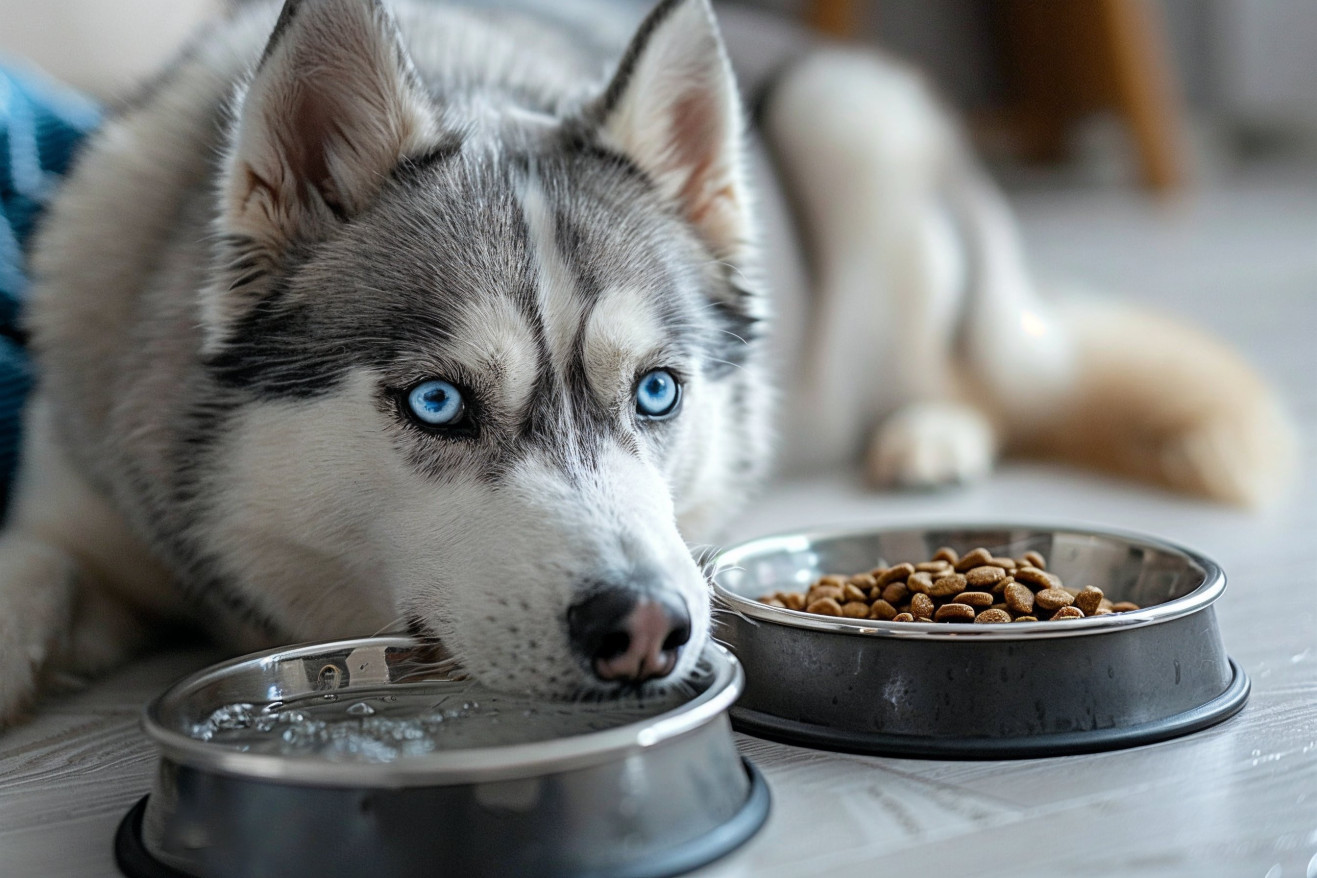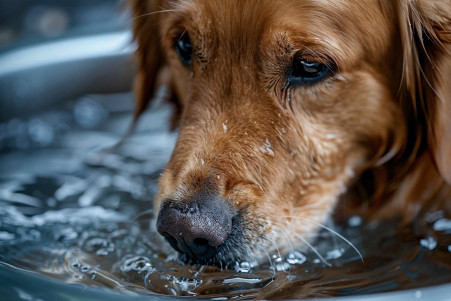Why Is My Dog Not Eating but Drinking Water?
21 February 2024 • Updated 20 February 2024

If your dog is drinking water but not eating, there are a few reasons this could be happening, including illness, dental issues, and anxiety.
If your dog has been refusing to eat for 24–48 hours, or if there are other symptoms that are concerning, it’s important to see a vet to make sure that there isn’t a more serious issue at play and to make sure that your dog is getting the proper nutrients and hydration.
In this article, we will explore a number of studies and expert opinions from the fields of veterinary medicine and animal nutrition to help you better understand why your dog might be refusing to eat while still drinking water.
This will include looking at research on some of the most common health problems that dogs face, the psychology of dogs, and the science of how dogs experience hunger and thirst. By doing this, we hope to give you a well-rounded view of why your dog might be refusing to eat.
Why is my dog not eating but drinking water?
Behavioral and Environmental Factors
A dog’s appetite is not just a matter of their physical needs; behavioral and environmental factors also come into play. For example, stress and anxiety can lead to a significant decrease in a dog’s appetite, while having little to no effect on their thirst.
A review in Antioxidants notes that stressful situations, including sudden changes in the environment, uncomfortable temperatures, and social conflicts, can cause a stress response that impacts eating behavior. This response involves the activation of the hypothalamus-pituitary-adrenal axis, which can result in a loss of appetite.
Changes in a dog’s environment can also impact their eating. Dogs need routine and any changes to their normal schedule can cause stress, which can impact their appetite but not their thirst.
In addition, a dog’s emotional state, including separation anxiety and anxiety due to changes in the household, can have a big impact on their appetite. A study in ScienceDirect by Sylvia García-Belenguer et al. notes that emotional eating, while not well-researched in dogs, is a well-documented phenomenon that has strong ties to a dog’s happiness and sense of security.
These factors are important to consider because they are all tied to a dog’s overall health and well-being, and they all lead to the more complicated topic of the physiological reasons for a dog’s loss of appetite.
The Physiology of the Problem: Why Dogs Won’t Eat but Will Drink Water
The regulation of a dog’s appetite is a complex physiological process. The central nervous system controls hunger and thirst, and a variety of neurotransmitters and hormones, including ghrelin and leptin, help determine the body’s energy balance.
Ghrelin, often referred to as the “hunger hormone,” is secreted when the stomach is empty and stimulates appetite. In contrast, leptin is secreted by fat cells and informs the brain when the body has had enough to eat, inhibiting hunger.
Disorders that impact these hormones can lead to a loss of appetite in dogs. For example, an increase in leptin levels may indicate leptin resistance, which is often found in dogs with obesity and higher body fat, according to BMC Veterinary Research.
This resistance can lead to a lack of hunger even when the body needs nutrients. On the other hand, other conditions, such as certain diseases or organ failure, including renal disease and endocrine disorders, can impact these hormones and lead to a loss of appetite.
A study by Dr. Joseph J. Wakshlag in PMC even suggests that changes in hormones like insulin can impact a dog’s appetite.
This is just one example of the many ways in which the regulation of a dog’s appetite is impacted. It’s clear that a dog’s decision to eat or not eat is not just a matter of whether they feel like eating at that moment. Instead, it’s a result of a variety of factors and signals that are as complex as the concept of health itself.
However, with careful observation and the help of a veterinarian, the reasons for a loss of appetite can be identified and treated, ensuring that our dogs stay both hydrated and well-nourished.
How to Make Sure Your Dog Is Getting the Right Nutrition and Hydration When They Won’t Eat
A dog’s willingness to eat is closely tied to nutritional balance. Dietary preferences, such as those examined in the study “Canine Food Preference Assessment of Animal and Vegetable Ingredient-Based Diets” from PMC, can impact a dog’s acceptance of their food.
When a dog is refusing to eat, it’s important for dog owners to make sure their pet is still drinking water to avoid dehydration, which can exacerbate other health problems and make a dog even less likely to eat.
A paper in StatPearls emphasizes the importance of hydration by explaining the role of water in maintaining a dog’s health, especially during exercise or in hot weather.
A study in Frontiers in Veterinary Science suggests that diets that include more animal-based ingredients may be more appealing to dogs and therefore more likely to be eaten when a dog has a low appetite. However, it’s important to be mindful of dietary changes and look for nutrient-dense options that are in line with a dog’s natural preferences. Adequate hydration supports these nutritional goals, as it’s essential for digestion and the absorption of nutrients.
Dog owners need to be vigilant about their dog’s nutrition and hydration, especially when their dog is refusing to eat. Long-term nutritional imbalances can lead to serious health problems, so maintaining the right balance of nutrition and hydration is key for dog owners who want to ensure their pet’s health and happiness.
How Smell and Taste Impact a Dog’s Sense of Hunger
The combination of smell and taste is incredibly important in a dog’s desire to eat. Dogs, who have an incredibly sensitive sense of smell that is much better than humans, use their olfactory system to both locate and choose food, as a study explained on PMC pointed out.
Tumors, infections, and other issues in the nasal cavity can impact a dog’s ability to use its olfactory and gustatory systems, which can lead to a dog not wanting to eat while still drinking water.
A study in Scientific Reports even went so far as to say that the importance of a dog’s olfactory system can’t be overstated, and even a small decrease in a dog’s ability to smell can have a big impact on its feeding behavior.
Meanwhile, a study in the Journal of Sensory Studies even introduced a way to measure the impact of an odor on a dog’s food choice, showing that smell is an important factor in a dog’s desire to eat. If a dog’s sense of smell or taste is impacted, it may lead to a dog refusing to eat.
Thankfully, dog owners can help increase a dog’s desire to eat by increasing the smell and taste of dog food. By appealing to a dog’s advanced sense of smell and the scents they prefer, an owner can help a dog want to eat. This is why it’s important for owners to understand a dog’s sensory-driven feeding behavior, especially when a dog’s eating habits change.
Conclusion: What to Know About Your Dog’s Eating and Drinking Habits
We’ve covered a lot of ground in explaining why a dog might not eat but still drink water, including behavioral, environmental, physiological, and sensory reasons. From the stress-related disruptions explained in Antioxidants to the nutritional balances highlighted in Frontiers in Veterinary Science, it’s clear that there are many factors that can impact a dog’s appetite.
It’s important to keep an eye on your dog’s eating and drinking habits. Make sure that you notice any changes that don’t go away. If your dog’s appetite doesn’t return to normal, getting help from a vet as soon as possible can help ensure that your dog gets the care they need.
We’ve also learned about the complex relationship between smell and taste in dogs and how it can impact their eating habits, as described in the Journal of Sensory Studies. This is important to keep in mind when you’re trying to get your dog to eat.
This research has shown how important it is to understand the many different factors that can impact a dog’s health and well-being. By keeping a close eye on their behavior and learning more about the reasons that their appetite may change, you can help make sure that your furry friend stays healthy and happy.


